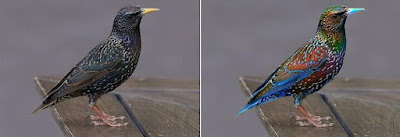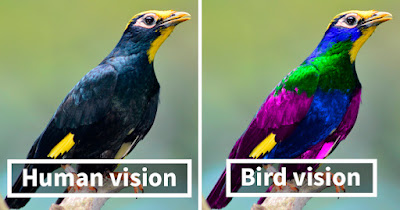Many birds and insects have receptors for colors that we humans can't see.

Starlings, for example, can see colors in reflected ultraviolet light that are beyond our human capacity. On the left is how starlings look to humans. On the right is how starlings may look to each other.
Image credit: Klaus Schmitt
According to Neringa Utaraitė: "Birds are tetrachromats, [so] they see four colors: UV, blue, green, and red, whereas we are trichromats and can only see three colors: blue, green, red. Bear in mind, that the magenta UV “color” shown here has been chosen to make it visible for us humans, it is a “false color”, as per definition UV light has no color."Thanks, Massimo via Bored Panda









7 comments:
We are always looking for new contributors to "stellamela.blogspot.com." If you are interested in submitting a guest post or collaborating with us, please contact us via email or social media. We look forward to hearing from you!
https://stellamela.blogspot.com/
Amazing. I wonder how being a tetrachromat affects perception of shadows? What kinds of things emit ambient UV? Does seeing UV contribute to the visual acuity of eagles and hawks? How can one make a painting of what it is to see in a wider spectrum? Do you know of any examples of someone who has attempted such a thing?
Then there are bichromats like dogs.
It makes me wonder if dinosaurs reflected colors in those spectrums and did they see themselves as the birds do. Thanks for the post!
It makes me wonder if dinosaurs also used those colors and saw themselves the same as birds.
I was thinking along these lines the other day on one of my walks. How ironic would it be if birds were color blind and all that show was for nothing? Your findings are the complete opposite and it made me laugh at my silly idea.
James have you heard of the Mantis Shrimp’s 16 receptors? I don’t have to do the math to be blown away by what their vision must look like! They’re very colorful critters, too, even to what we can see.
@skertina
Post a Comment